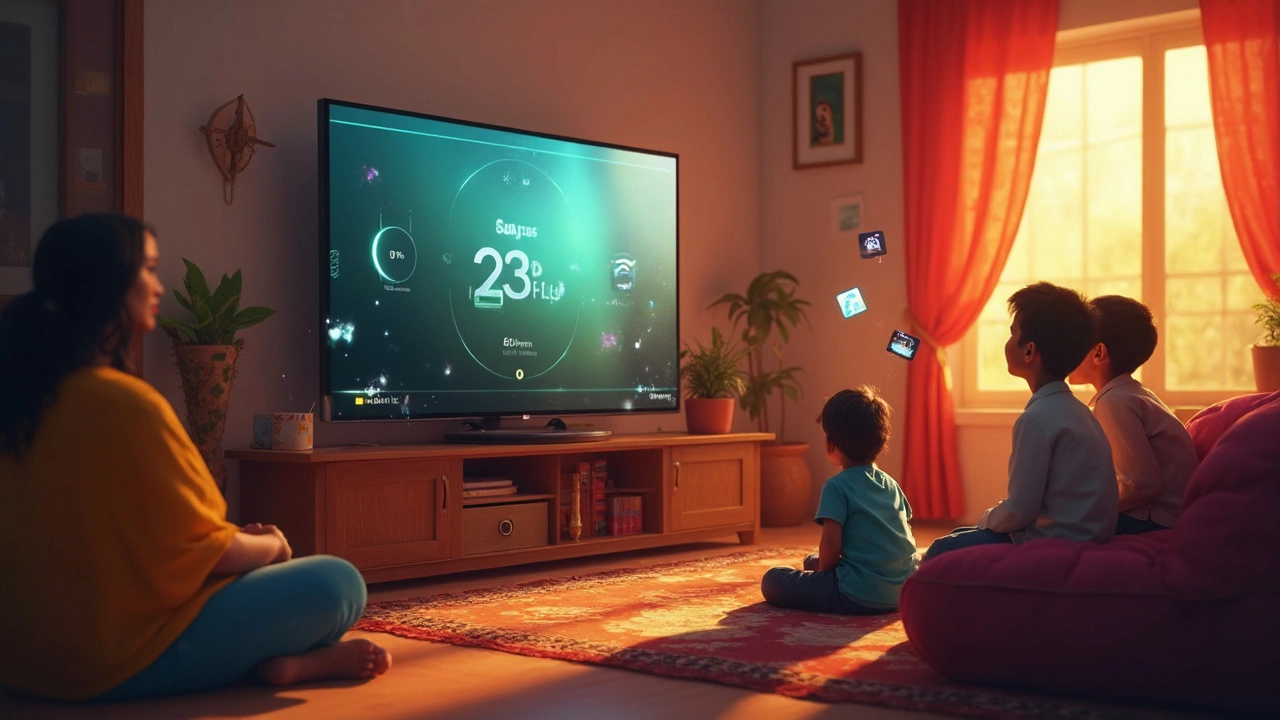
Most people get a new smart TV and assume it'll stick around for almost as long as their old tube TV did. But the truth? Your smart TV’s life expectancy is a lot shorter than you might think. We're not just talking about being able to turn on the screen—a smart TV’s real age shows in picture quality, speed, and how up-to-date it feels with new apps.
If you use your TV like a typical person (that’s about 5 hours a day), the average smart TV from a major brand usually lasts between 5 and 8 years before you start noticing issues. Some folks squeeze out 10 years, while others get hit with glitches or dim screens much sooner. It’s not just about hardware—the software matters too. When updates stop, you’ll find some streaming apps just… vanish or keep crashing. That alone forces a lot of people to upgrade quicker than expected. So, when you’re picking a TV, don’t just look at the specs—think about how well the brand supports updates, too.
- How Long Do Smart TVs Usually Last?
- What Actually Wears Out a Smart TV?
- Tips to Make Your TV Last Longer
- When Is It Time for a New TV?
How Long Do Smart TVs Usually Last?
Let’s cut to the chase: the average smart TV holds up for about 6 to 8 years if you’re using it normally—think around five hours per day. That number can stretch to a decade if you really baby it or just get lucky with a rock-solid model, but most people hit problems before then. These aren’t just guesses either—big brands like Samsung and LG put their TVs through tests and most land in this range.
The main thing that wears a TV out is the backlight (for LED and LCD sets). Once it starts dimming, picture quality takes a nosedive. OLED TVs look gorgeous, but the organic materials in their screens can wear out a bit faster with heavy use, leading to dim spots called burn-in. You’ll also run into software issues as TV makers push new updates that your older TV just can’t handle anymore.
Here’s a quick breakdown of how long you can expect top brands to last if you use your TV 5 hours a day:
| Brand | Expected Lifespan (Years) | Common Issues |
|---|---|---|
| Samsung | 7-8 | Backlight loss, outdated apps |
| LG | 6-8 | Burn-in for OLED, dimming LEDs |
| Sony | 7-10 | Slower software, panel issues |
| TCL / Hisense | 5-7 | Panel flicker, OS lags |
It’s worth mentioning that some smart TVs will keep working past these numbers, just not as well. You’ll notice lag, weird lines, or apps that just won’t load. While you can sometimes fix small problems, when your TV feels slow and outdated, it’s usually time to move on.
Want your TV to last closer to that 10-year mark? Lower the backlight setting, keep the TV out of direct sunlight, and run software updates regularly. These tweaks can help push your TV’s lifespan a bit further.
What Actually Wears Out a Smart TV?
So, what’s actually making your smart TV age faster than you’d like? First up, the screen—this is almost always the weak spot. If you’ve got an OLED TV, be extra careful with static images (like menus or news tickers) because OLED panels are more likely to develop burn-in after a few years. LED or LCD screens can also fade, but usually they just get dimmer or start showing weird colors as the backlight wears out.
The next thing that really goes is the internal electronics. The motherboard, processing chips, and even the power supply all take a beating every day you watch. Heat is the big enemy here. If your TV runs hot—maybe because it’s wall-mounted in a tight spot—it’ll age way faster. Dust can make this worse by clogging vents and blocking airflow, so it pays to keep things clean.
Software is the silent killer. Over time, manufacturers stop rolling out updates. That means your TV’s apps might not work, the system can lag, and security holes can pop up. This is usually why folks give up on their TV way before the hardware totally fails.
Even remote controls and HDMI ports wear out. If you’re constantly swapping devices or dropping the remote, those moving parts don’t last forever either. And if you use your TV as a gaming display? Heavy gaming can push the TV harder, especially the processor and panel, often speeding up wear and tear.

Tips to Make Your TV Last Longer
If you want to squeeze every last year out of your smart TV, you have more control than you think. Most people lose years on their TV’s life thanks to habits that are easy to fix. Here’s what actually works:
- smart TV placement is key. Avoid putting your TV in direct sunlight or right next to a heater. Heat and light speed up the breakdown of the screen—especially on OLED and QLED panels.
- Use a decent surge protector. Power surges from thunderstorms or grid hiccups can fry your TV’s main board in a split second. A $20 surge strip can save you from buying a whole new TV.
- Don’t crank brightness all the way up. Most TVs come with showroom mode (super bright to pop in stores), but keeping it high wears out the backlighting much faster. Dial it down—it’s easier on the eyes and adds years to your screen.
- Turn it off if you’re not watching. Seems obvious, but tons of people leave their TV streaming music videos, news, or background noise all day. These hours add up fast and eat into your TV’s rated lifespan.
- Dust your TV regularly. Dust can clog vents, causing the set to run hot, which wears down the electronics inside. Just hit it with a microfiber cloth once a week and use a can of air for the vents every couple months.
- Keep software updated. Yes, those update popups are annoying, but they often include bug fixes, smoother performance, and even security patches to keep your apps running longer.
Here’s a quick look at how much certain habits can boost (or wreck) your TV years:
| Habit | Impact on TV Life Expectancy | Extra Life (average) |
|---|---|---|
| Lower screen brightness | Slower backlight wear | +1 to 2 years |
| Surge protection | Prevents instant failure from power surges | Can avoid sudden early death |
| Turning TV off when not in use | Reduces used hours per year | +1 to 3 years |
| Keeping software updated | App and OS support lingers longer | Apps work for full hardware life |
| Proper ventilation/dusting | Prevents overheating | +1 year |
Just changing a few habits can push your TV from a standard 6-year run to closer to 8 or even 10. These little things add up—especially with pricier models. Be intentional, and your TV will serve you way longer than you expect.
When Is It Time for a New TV?
It’s not always obvious when your TV has finally hit the wall. Most folks hang on longer than they should, hoping to get just one more year out of it. If you notice streaming apps freezing up, colors looking bland, or the TV taking forever to load menus, that’s your first big clue. But it’s not just about annoyance—these are hints that the guts of your TV can’t keep up anymore.
If your smart TV can’t download new apps, loses support for big streaming services like Netflix or Disney+, or the remote only works after you’ve smacked it a few times, things are going downhill. Manufacturers like Samsung, LG, and Sony usually stop pushing software updates after 5 to 7 years. After that, you’re stuck with whatever features and bugs you’ve got.
Screen problems are another big red flag. Dead pixels, permanent lines, or patches of color that don’t look right mean the panel is wearing out. For LED and OLED TVs, burned-in images (where ghost shapes just won’t go away) are pretty common if you leave a static image on for hours every day.
Here’s a quick table showing common signs it’s time to upgrade and what they probably mean:
| Sign | What It Means |
|---|---|
| Apps crashing or missing | Software outdated, likely unsupported |
| Screen is dim, flickering, or has dead spots | Panel is wearing out (common after 6+ years) |
| No more updates from manufacturer | Security and compatibility issues |
| Slow loading or random reboots | Processor struggling with new apps; internal wear |
| HDMI ports or remote stop working | Physical wear or outdated support tech |
You don’t have to wait until your TV is completely dead. In fact, upgrading while your old TV still works means you can sell it (or give it away) while it still has some value. Plus, new smart TVs are more energy efficient, run smoother, and offer better screen tech for the same money compared to five years ago.
The key question to ask: Is dealing with daily glitches or missing features worth the headache? Once you hit two or more of these symptoms, it’s usually time to start shopping for a replacement. And keep in mind—smart TV deals are everywhere if you hit the right sale.